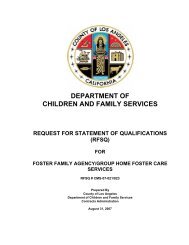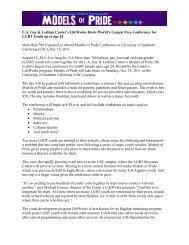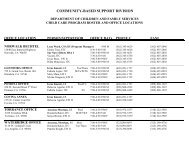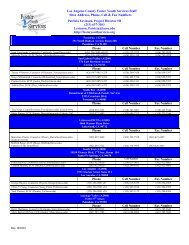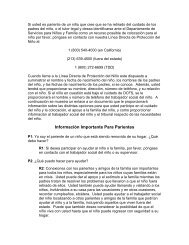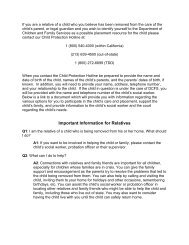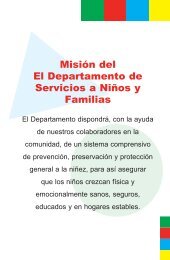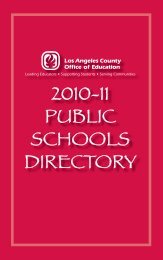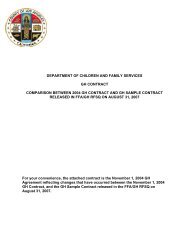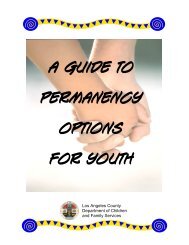Phases and Activities of the Wraparound Process - Los Angeles ...
Phases and Activities of the Wraparound Process - Los Angeles ...
Phases and Activities of the Wraparound Process - Los Angeles ...
Create successful ePaper yourself
Turn your PDF publications into a flip-book with our unique Google optimized e-Paper software.
<strong>Phases</strong> <strong>and</strong> activities <strong>of</strong> <strong>the</strong> wraparound process 6<br />
MAJOR TASKS/Goals ACTIVITIES NOTES<br />
1.2. Stabilize crises<br />
GOAL: To address pressing<br />
needs <strong>and</strong> concerns so that<br />
family <strong>and</strong> team can give <strong>the</strong>ir<br />
attention to <strong>the</strong> wraparound<br />
process.<br />
1.3. Facilitate conversations<br />
with family <strong>and</strong> youth/child<br />
GOAL: To explore individual <strong>and</strong><br />
family strengths, needs, culture,<br />
<strong>and</strong> vision <strong>and</strong> to use <strong>the</strong>se to<br />
develop a document that will<br />
serve as <strong>the</strong> starting point for<br />
planning.<br />
1.2 a. Ask family <strong>and</strong> youth about immediate crisis<br />
concerns<br />
Facilitator elicits information from <strong>the</strong> family <strong>and</strong> youth<br />
about immediate safety issues, current crises, or crises<br />
that <strong>the</strong>y anticipate might happen in <strong>the</strong> very near future.<br />
These may include crises stemming from a lack <strong>of</strong> basic<br />
needs (e.g., food, shelter, utilities such as heat or<br />
electricity).<br />
1.2 b. Elicit information from agency representatives<br />
<strong>and</strong> potential team members about immediate crises<br />
or potential crises<br />
Facilitator elicits information from <strong>the</strong> referring source <strong>and</strong><br />
o<strong>the</strong>r knowledgeable people about pressing crisis <strong>and</strong><br />
safety concerns.<br />
1.2 c. If immediate response is necessary, formulate a<br />
response for immediate intervention <strong>and</strong>/or<br />
stabilization<br />
Facilitator <strong>and</strong> family reach agreement about whe<strong>the</strong>r<br />
concerns require immediate attention <strong>and</strong>, if so, work to<br />
formulate a response that will provide immediate relief<br />
while also allowing <strong>the</strong> process <strong>of</strong> team building to move<br />
ahead.<br />
1.3 a. Explore strengths, needs, culture, <strong>and</strong> vision<br />
with child/youth <strong>and</strong> family.<br />
Facilitator meets with <strong>the</strong> youth/child <strong>and</strong> family to hear<br />
about <strong>the</strong>ir experiences; ga<strong>the</strong>r <strong>the</strong>ir perspective on <strong>the</strong>ir<br />
individual <strong>and</strong> collective strengths, needs, elements <strong>of</strong><br />
culture, <strong>and</strong> long-term goals or vision; <strong>and</strong> learn about<br />
natural <strong>and</strong> formal supports. Facilitator helps family identify<br />
potential team members <strong>and</strong> asks family to talk about<br />
needs <strong>and</strong> preferences for meeting arrangements<br />
(location, time, supports needed such as child care,<br />
translation).<br />
A Product <strong>of</strong> <strong>the</strong> National <strong>Wraparound</strong> Initiative – October 10, 2004 version<br />
The goal <strong>of</strong> this activity is to quickly address <strong>the</strong> most<br />
pressing concerns. The whole team engages in<br />
proactive <strong>and</strong> future-oriented crisis/safety planning<br />
during phase 2. As with o<strong>the</strong>r activities in this phase,<br />
<strong>the</strong> goal is to do no more than necessary prior to<br />
convening <strong>the</strong> team, so that <strong>the</strong> facilitator does not<br />
come to be viewed as <strong>the</strong> primary service provider <strong>and</strong><br />
so that team as a whole can feel ownership for <strong>the</strong> plan<br />
<strong>and</strong> <strong>the</strong> process.<br />
Information about previous crises <strong>and</strong> <strong>the</strong>ir resolution<br />
can be useful in planning a response in 1.2.c.<br />
This response should describe clear, specific steps to<br />
accomplish stabilization.<br />
This activity is used to develop information that will be<br />
presented to <strong>and</strong> augmented by <strong>the</strong> team in phase 2.<br />
Family members should be encouraged to consider<br />
<strong>the</strong>se topics broadly.



